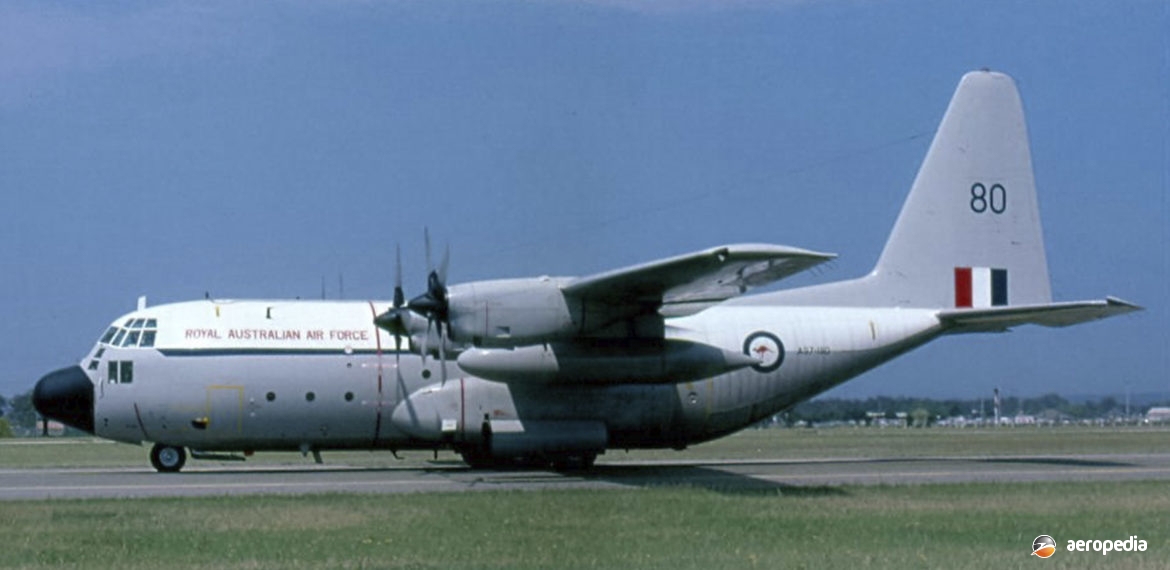Photograph:
Lockheed C-130E Hercules A97-180 (c/n 4180) at RAAF Richmond, NSW (David C Eyre)
Country of origin:
United States of America
Description:
Military tactical transport
Power Plant:
Four 3,020 kw (4,050 eshp) Allison T56-A-7A turboprops
Specifications:
Length: 29.78 m (97 ft 9 in)
Height: 11.68 m (38 ft 4 in)
Wing area: 161.12 m² (1,745 sq ft)
Max cruising speed: 587 km/h (365 mph)
Rate of climb at sea level at max loaded weight: 472 m/min (1,550 ft/min)
Take-off distance to 15 m (50 ft) at 70,310 kg (155,000 lb): 1,783 m (5,850 ft)
Landing distance from 15 m (50 ft) at 45,360 kg (100,000 lb): AUW 732 m (2,400 ft)
Range with 14,830 kg (32,700 lb) payload at 547 km/h (340 mph): 5,875 km (3,650 miles)
Range with max fuel and 8,980 kg (19,800 lb) payload at 547 km/h (340 mph): 7,805 km (4,850 miles)
Empty weight: 32,795 kg (72,300 lb)
Max payload weight: 14,833 kg (32,700 lb)
Loaded weight: 70,310 kg (155,000 lb)
History:
Development of the Hercules has continued over the years. After the C-130A was the C-130B, which differed from the C-130A in having up-rated T56-A-7 engines and four-blade Hamilton Standard propellers in place of the three-blade Aeroproducts units. This was followed by the C-130C, of which only one was built; the C-130D, which was a C-130A modified for Antarctic work; and then the C-130E, the third basic transport variant, which was developed in 1961 primarily as interim modernisation equipment for the US Military Air Transport Service. Subsequently it was purchased for Tactical Air Command and a number of overseas operators. Entering service in 1962, the C-130E was essentially a C-130B with two 5,150 litre (1,133 Imp gal) fuel tanks under the wings and more powerful engines. Other improvements included structural improvements, an avionics upgrade and higher gross weight.
Twelve were purchased for No 37 Squadron, RAAF, based at Richmond, NSW, to supplement the C-130As, and these, as was the normal practice at that time, were serialled using the manufacturer’s construction number as A97-159 (c/n 4159 – ser 65-12896), A97-160 (c/n 4160 – ser 65-12897), A97-167 (c/n 4167 – ser 65-12898), A97-168 (c/n 4168 – ser 65-12899), A97-171 (c/n 4171 – ser 65-12900), A97-172 (c/n 4172 – ser 65-12901), A97-177 (c/n 4177 – ser 65-12902), A97-178 (c/n 4178 – ser 65-12903), A97-180 (c/n 4180 – ser 65-12904), A97-181 (c/n 4181 – ser 65-12905), A97-189 (c/n 4189 (ser 65-12906), and A97-190 (c/n 4190 – ser 65-12907).
The first C-130E was received on 24 August 1966 by No 37 Squadron, which had been disbanded at Schofields in 1948, and re-activated to take delivery of the C-130Es. Apart from the four-blade propellers, these aircraft could be distinguished from the C-130As by the 1,703 litre (450 US / 375 Imp gal) underwing tanks between the engines on each side. On the C-130A they were outboard of the engines.
The C-130E was retired from RAAF service, being traded to Lockheed Martin on the C-130Js. They were refurbished, six later being sold to Pakistan. In Pakistan Air Force service they still used their construction number, eg A97-159 becoming serial 4159, this aircraft being rebuilt to Super E standard with T56-A-15 engines. Others rebuilt to this standard by Lockheed for Pakistan included A97-171 (to 4171); A97-177 (to 4177); A97-178 (to 4178); A97-180 (to 4180) and A97-189 (to 4189). A97-167 ended up at RAAF Richmond, NSW for battle damage repair work. A97-168 was retired after wing cracks were found and it was used at Richmond for loader training. A97-190 was disassembled in May 2000 and also used for loading training at Richmond. A97-181 was noted in Delaware in the US after being broken up. A97-172 was taken to Holsworthy Army Barracks in March 2000 for training purposes and A97-160 was flown to Point Cook to join the RAAF Museum.

